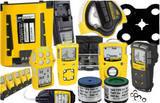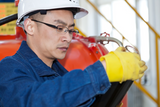Blog
Calibrating Your Confined Space Gas Monitors
Confined space 4-gas monitors need to be calibrated. We all know it, and the time is probably coming up soon. Just how often you are required to calibrate depends on you and the recommendations of the manufacturer. (See
calibration intervals for more information.) There are several possible methods for tuning up your gas monitor, and whether you do manual calibrations, use an automated calibration and bump test device, or send it in for a professional calibration service is up to you.
…
Feb 25th 2016
Don't Use Expired Calibration Gas to Test Monitors
Gas produced and put into bottles for bump testing and
calibrating gas monitors has a finite shelf life, and paying attention to that expiration date might save your life. Using expired gas can lead to incorrect calibration of your gas monitor.
Gas concentrations have been known to drop over time. Reactive gases such as hydrogen sulfide react with the material of the cylinder container, and tests have shown some levels to slip from 20 parts per million (ppm) to 6 ppm over a 12-month peri
…
Jun 26th 2015
Bump Test Gas Cylinder: How Many Bump Tests Do I Get From a Cylinder of Gas?
A good customer (all our customers are good, of course) recently asked us to figure out exactly how many bump tests they would get from a
58L of NIST Traceable Gas for their new Gas Clip Technologies Multi Gas Clip (MGC) Monitors (with 2 month battery charge life). The quick answer - a little over 300, and maybe as many as 600. But there's a catch.
Calibration gas has a shelf like. It's longer than a gallon of milk, but still shorter than you might expect. The 4-gas mixture for
…
Jan 28th 2015
Gas Detector Bump Test: Bump Testing and Calibration of your Gas Monitors
Gas monitors need regular calibration and bump testing if you want to be sure they are working properly. Like a guitar, monitors can drift out of tune. You've got a couple of choices to get it working properly. And as everyone who owns a gas monitor knows - whether it's a multi-gas monitor like the GasAlert Micro Clip XT, or a single-gas monitor like the
Gas Clip Technologies H2S Monitor - a quick bump test before using it to protect your life is an excellent, and highly recommen
…
Jan 14th 2015
BW Honeywell Factory-Trained Gas Monitor Know-It-Alls
Before we upgraded our facilities, sent our tech guys to Level 3 BW Honeywell gas monitor training, and increased our factory-direct parts supply to become a
BW Factory Authorized Service Center, these guys were already pretty unbearable. Sure it was handy to have someone around who could drill down to the smallest detail of monitor capabilities and explain error codes while grabbing their lunch from the company fridge. It's the calibration knowledge, the sensor life, the warranty informat
…
Jan 8th 2015
BW Honeywell Parts and Accessories - All Of Them
We've always carried a great selection of
gas monitors from BW Honeywell. And we've always had the important related items like the MicroDock II Docking Stations. We've even had loads of sensors and accessories. But now we have all of them.
That's right. Everything. The whole gas-detecting enchilada. Everything you've ever wanted from BW Honeywell pertaining to the monitors we sell is now available on our site. Every
hydrophobic pump filter, every set of replacement screws for you
…
Jun 18th 2014
Which Gas Cylinder Regulator Do I Need For My Gas Monitor?
All gas monitors need to be bump tested, even if they don't require calibration. (Yes, that goes for you guys with single gas disposable monitors too.) To test your monitor you're going to need both
calibration gas and a regulator. Your calibration gas mixture will be determined by the type of sensors in your gas monitor. Your regulator will have to fit your bottle of gas. Problem is there are a couple of different types of regulators, and it's not very intuitive figuring out which you'll
…
May 19th 2014
H2S Monitor Bump Test: How Often Should My H2S Monitor Be Bump Tested?
A customer from the Chinese division of a large petroleum company emailed us this week to ask how often their
BW Clip H2S Monitors should be bump tested. Since we sell more of these monitors than any other at PK Safety Supply, it would seem logical that we'd have a ready answer. But we don't.
It's not because we don't care, or we don't think it's important. It is. Here's the situation: Officially, the manufacturer BW Honeywell recommends periodically testing the response of the hydro
…
Apr 28th 2014
How-to: BW Honeywell Gas Detector Calibration
Calibration is very important for a gas monitor. It reestablishes a base line accuracy for the sensors, both electro-chemical and LEL catalytic bead. In order to perform as they were designed, gas monitors need to periodically be readjusted in the same way a guitar string needs tuning. Calibration of your gas monitors isn't difficult or time consuming (unless you have several hundred monitors, in which case it can be very tedious) and it's essential for accurate measurements over time.
…
Oct 24th 2013
Gas Monitor Repair and Warranty Information
Gas monitors are made to be used on some of the toughest job sites in the world. Industrial chemical and gas facilities are made for production, not comfort, and the safety of the workers depends on gas monitors doing their job day in and day out.
Because so much is riding on the accuracy of these gas detection devices, regular calibration and testing is necessary. When sensors wear out or are overloaded, or when regular maintenance and re-certification is required, it takes trained tec
…
Jul 25th 2013











